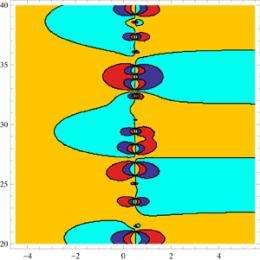A zero sum game

(PhysOrg.com) -- New light has been shed on the 150-year-old math puzzle known as the Riemann hypothesis, say mathematical physicists at the University of Sydney.
The Riemann hypothesis relates to the location of the zeros of a one-dimensional sum, which is known as the Riemann zeta function.
Along with suitable generalisations, it is considered by some mathematicians to be the most prominent challenge in pure mathematics.
"The celebrated Riemann hypothesis is generally recognised as being the most outstanding unsolved problem in mathematics," says Professor Ross McPhedran from the School of Physics.
"Until now the full version of the hypothesis has remained unsolved, although modern computer calculations have shown that the first 10 trillion zeros lie on the critical line."
In a paper to be published in the March edition of the Proceedings of the Royal Society A, Professor Ross McPhedran and colleagues from the University of Sydney and the University of Technology, Sydney considered two-dimensional sums.
"We have identified a previously uninvestigated class of two-dimensional sums which depend on angles in the plane as well as distances.
"We have shown that these angular sums all satisfy the Riemann hypothesis if and only if the basic two-dimensional sum satisfies it.
"We have also proved that the distributions of zeros of these sums are all the same."
It is hoped that these new insights will give mathematicians new tools which will enable them to finally prove the Riemann hypothesis, thereby deepening our understanding of the distribution of prime numbers.
More information: rspa.royalsocietypublishing.org/
Provided by University of Sydney

















